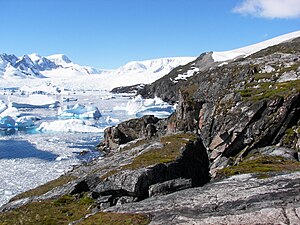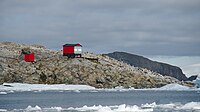Difference between revisions of "Cierva Cove"
(Created page with "{{territory|BAT}} '''Cierva Cove''' is a small bay on the Danco Coast of Graham Land, within the British Antarctic Territory. It lies to the east of Cierva Poin...") |
|||
| Line 1: | Line 1: | ||
| + | [[File:Base Primavera Foto Miguel Angel Otero Soliño.JPG|right|thumb|300px|Cierva Cove]] | ||
{{territory|BAT}} | {{territory|BAT}} | ||
'''Cierva Cove''' is a small bay on the [[Danco Coast]] of [[Graham Land]], within the [[British Antarctic Territory]]. It lies to the east of [[Cierva Point]] within [[Hughes Bay]]. | '''Cierva Cove''' is a small bay on the [[Danco Coast]] of [[Graham Land]], within the [[British Antarctic Territory]]. It lies to the east of [[Cierva Point]] within [[Hughes Bay]]. | ||
| Line 5: | Line 6: | ||
It is named in association with the names of pioneers of aviation grouped in this area, after Juan de la Cierva (1895-1936), the Spanish inventor of the autogyro, the first successful rotating-wing aircraft, in 1923. | It is named in association with the names of pioneers of aviation grouped in this area, after Juan de la Cierva (1895-1936), the Spanish inventor of the autogyro, the first successful rotating-wing aircraft, in 1923. | ||
| + | |||
| + | ==Capitán Cobbett Refuge== | ||
| + | [[File:Primavera Base, Cierva Cove (46567604444).jpg|right|thumb|200px|Capitán Cobbett Refuge]] | ||
| + | Refuge Capitán Cobbett is an Argentine refuge in Antarctica built on the shore of Cierva Cove, inaugurated in 1954 with the name of 'Naval refuge Cape Primavera. The refuge is a small building that currently has the function of a laboratory; it has two rooms and a bathroom, and has supplies for three men for three months. The name pays tribute to Captain Enrique Cobbett, who died in August 1826 in the shipwreck of the frigate ''Buenos Aires'' on Cape Horn. | ||
==Location== | ==Location== | ||
Latest revision as of 17:54, 11 August 2021
Cierva Cove is a small bay on the Danco Coast of Graham Land, within the British Antarctic Territory. It lies to the east of Cierva Point within Hughes Bay.
The cove was photographed from the air by the Falkland Islands and Dependencies Aerial Survey Expedition in 1956-57 and surveyed from the ground by the Falkland Islands Dependencies Survey from Portal Point in 1957-58.
It is named in association with the names of pioneers of aviation grouped in this area, after Juan de la Cierva (1895-1936), the Spanish inventor of the autogyro, the first successful rotating-wing aircraft, in 1923.
Capitán Cobbett Refuge
Refuge Capitán Cobbett is an Argentine refuge in Antarctica built on the shore of Cierva Cove, inaugurated in 1954 with the name of 'Naval refuge Cape Primavera. The refuge is a small building that currently has the function of a laboratory; it has two rooms and a bathroom, and has supplies for three men for three months. The name pays tribute to Captain Enrique Cobbett, who died in August 1826 in the shipwreck of the frigate Buenos Aires on Cape Horn.
Location
- Location map: 64°9’23"S, 60°52’23"W
References
- Gazetteer and Map of The British Antarctic Territory: Cierva Cove

